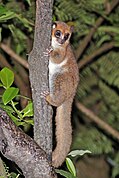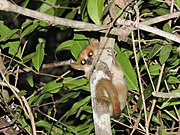
A | B | C | D | E | F | G | H | CH | I | J | K | L | M | N | O | P | Q | R | S | T | U | V | W | X | Y | Z | 0 | 1 | 2 | 3 | 4 | 5 | 6 | 7 | 8 | 9

Lemuroidea is a superfamily of primates. Members of this superfamily are called lemuroids, or lemurs. Lemuroidea is one of two superfamilies that form the suborder Strepsirrhini, itself one of two suborders in the order Primates. They are found exclusively on the island of Madagascar, primarily in forests but with some species also in savannas, shrublands, or wetlands. They range in size from the Margot Marsh's mouse lemur, at 8 cm (3 in) plus a 11 cm (4 in) tail, to the indri, at 90 cm (35 in) plus a 6 cm (2 in) tail. Lemuroids primarily eat fruit, leaves, and insects. Most lemuroids do not have population estimates, but the ones that do range from 40 mature individuals to 5,000. Most lemuroid species are at risk of extinction, with 45 species categorized as endangered, and a further 32 species categorized as critically endangered.
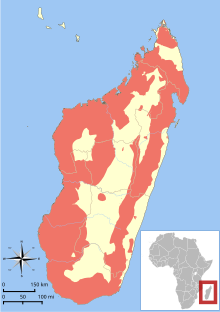
The 107 extant species of Lemuroidea are divided into five families. Cheirogaleidae contains 41 dwarf, mouse, and fork-marked lemur species in five genera. Daubentoniidae contains a single species, the aye-aye. Indriidae contains nineteen woolly lemur and sifaka species in three genera. Lemuridae contains 21 ruffed, ring-tailed, bamboo, and other lemur species in five genera. Lepilemuridae contains 25 sportive lemur species in a single genus.
Dozens of extinct prehistoric lemuroid species have been discovered, though due to ongoing research and discoveries the exact number and categorization is not fixed.[1] At least 17 species and eight genera are believed to have become extinct in the 2,000 years since humans first arrived in Madagascar.[2][3] All known extinct species were large, ranging in weight from 10 to 200 kg (22 to 441 lb). The largest known subfossil lemur was Archaeoindris fontoynonti, a giant sloth lemur, which weighed more than a modern female gorilla. The extinction of the largest lemurs is often attributed to predation by humans and possibly habitat destruction.[2] Since all extinct lemurs were not only large (and thus ideal prey species), but also slow-moving (and thus more vulnerable to human predation), their presumably slow-reproducing and low-density populations were least likely to survive the introduction of humans.[2] Gradual changes in climate have also been blamed, and may have played a minor role; however since the largest lemurs also survived the climatic changes from previous ice ages and only disappeared following the arrival of humans, it is unlikely that climatic change was largely responsible.[2]
Conventions
| Conservation status | |
|---|---|
| EX | Extinct (0 species) |
| EW | Extinct in the wild (0 species) |
| CR | Critically Endangered (32 species) |
| EN | Endangered (45 species) |
| VU | Vulnerable (24 species) |
| NT | Near threatened (1 species) |
| LC | Least concern (2 species) |
| Other categories | |
| DD | Data deficient (3 species) |
| NE | Not evaluated (0 species) |
Conservation status codes listed follow the International Union for Conservation of Nature (IUCN) Red List of Threatened Species. Range maps are provided wherever possible; if a range map is not available, a description of the lemuroid's range is provided. Ranges are based on the IUCN Red List for that species unless otherwise noted.
Classification
The superfamily Lemuroidea consists of five extant families: Cheirogaleidae, Daubentoniidae, Indriidae, Lemuridae, and Lepilemuridae. Cheirogaleidae contains 41 species in five genera. Daubentoniidae contains a single species. Indriidae contains nineteen species in three genera. Lemuridae contains 21 species in five genera. Lepilemuridae contains 25 lemur species in a single genus. There are additionally three families which went extinct prior to modern record-keeping: Archaeolemuridae, Megaladapidae, and Palaeopropithecidae, as well as an extinct genus in Lemuridae.
Family Archaeolemuridae† (monkey lemurs)
- Genus Archaeolemur†: two extinct species
- Genus Hadropithecus†: one extinct species
Family Cheirogaleidae
- Genus Allocebus (hairy-eared dwarf lemur): one species
- Genus Cheirogaleus (dwarf lemurs): ten species
- Genus Microcebus (mouse lemurs): twenty-four species
- Genus Mirza (giant mouse lemurs): two species
- Genus Phaner (fork-marked lemurs): four species
Family Daubentoniidae
- Genus Daubentonia (aye-aye): one species
Family Indriidae
- Genus Avahi (woolly lemurs): nine species
- Genus Indri (indri): one species
- Genus Propithecus (sifakas): nine species
Family Lemuridae
- Genus Eulemur (true lemurs): twelve species
- Genus Hapalemur (bamboo lemurs): five species
- Genus Lemur (ring-tailed lemur): one species
- Genus Pachylemur†: two extinct species
- Genus Prolemur (greater bamboo lemur): one species
- Genus Varecia (ruffed lemurs): two species
Family Lepilemuridae
- Genus Lepilemur (sportive lemurs): twenty-five species
Family Megaladapidae† (koala lemurs)
- Genus: Megaladapis†
Family Palaeopropithecidae† (sloth lemurs)
- Genus: Archaeoindris†: one extinct species
- Genus: Babakotia†: one extinct species
- Genus: Mesopropithecus†: three extinct species
- Genus: Palaeopropithecus†: three extinct species
| |||||||||||||||||||||||||||
| |||||||||||||||||||||||||||
| There are two competing lemur phylogenies, one by Horvath et al. (top)[4] and one by Orlando et al. (bottom).[5] |
Lemuroids
The following classification is based on the taxonomy described by the reference work Mammal Species of the World (2005), with augmentation by generally accepted proposals made since using molecular phylogenetic analysis, as supported by both the IUCN and the American Society of Mammalogists.[6]
Family Cheirogaleidae
| Common name | Scientific name and subspecies | Range | Size and ecology | IUCN status and estimated population |
|---|---|---|---|---|
| Hairy-eared dwarf lemur | A. trichotis (Günther, 1875) |
Northeastern Madagascar
|
Size: 12–15 cm (5–6 in) long, plus about 17 cm (7 in) tail[7] Habitat: Forest[8] Diet: Nectar, fruit, gum, leaves, honey, and insects[8] |
EN
|
| Common name | Scientific name and subspecies | Range | Size and ecology | IUCN status and estimated population |
|---|---|---|---|---|
| Ankarana dwarf lemur
|
C. shethi Frasier et al., 2016 |
Northern Madagascar | Size: 16–18 cm (6–7 in) long, plus about 18 cm (7 in) tail[9] Habitat: Forest and shrubland[10] Diet: Fruit[10] |
EN
|
| Fat-tailed dwarf lemur | C. medius Geoffroy, 1812 |
Southern, western, and northern Madagascar
|
Size: 20–23 cm (8–9 in) long, plus 20–27 cm (8–11 in) tail[11] Habitat: Forest[12] Diet: Fruit, as well as flowers, seeds, nectar, insects, and small vertebrates[11] |
VU
|
| Furry-eared dwarf lemur | C. crossleyi Grandidier, 1870 |
Scattered eastern Madagascar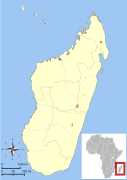
|
Size: 22–26 cm (9–10 in) long, plus 21–27 cm (8–11 in) tail[13] Habitat: Forest[14] Diet: Nectar, fruit, leaves, and insects[13] |
VU
|
| Greater dwarf lemur | C. major Geoffroy, 1812 |
Eastern Madagascar
|
Size: 16–27 cm (6–11 in) long, plus 19–31 cm (7–12 in) tail[15] Habitat: Forest[16] Diet: Fruit, flowers, and nectar, as well as insects small vertebrates, and honey[15] |
VU
|
| Groves' dwarf lemur | C. grovesi McLain et al., 2017 |
Southeastern Madagascar | Size: 16–24 cm (6–9 in) long, plus 27–31 cm (11–12 in) tail[17] Habitat: Forest[18] Diet: |
DD
|
| Lavasoa dwarf lemur
|
C. lavasoensis Thiele, Razafimahatratra, & Hapke, 2013 |
Southern Madagascar | Size: 50–55 cm (20–22 in) long, including tail[19] Habitat: Forest[20] Diet: |
EN
|
| Lesser iron-gray dwarf lemur
|
C. minusculus Groves, 2000 |
Central Madagascar
|
Size: Unknown[21] Habitat: Forest[22] Diet: Unknown[21] |
DD
|
| Montagne d'Ambre dwarf lemur
|
C. andysabini Lei et al., 2015 |
Northern Madagascar | Size: 16–18 cm (6–7 in) long, plus 26–27 cm (10–11 in) tail[23] Habitat: Forest[24] Diet: |
EN
|
| Sibree's dwarf lemur
|
C. sibreei Forsyth Major, 1896 |
Eastern Madagascar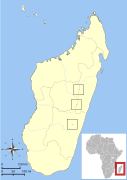
|
Size: Unknown[25] Habitat: Forest[26] Diet: Unknown[25] |
CR
|
| Thomas' dwarf lemur | C. thomasi (Forsyth Major, 1894) |
Southeastern Madagascar | Size: Unknown Habitat: Forest[27] Diet: Fruit and flowers[27] |
EN
|
| Common name | Scientific name and subspecies | Range | Size and ecology | IUCN status and estimated population |
|---|---|---|---|---|
| Anosy mouse lemur
|
M. tanosi Rasoloarison, Weisrock, Yoder, Rakotondravony, & Kappeler, 2013 |
Southeastern Madagascar | Size: 10–16 cm (4–6 in) long, plus 11–15 cm (4–6 in) tail[28] Habitat: Forest[29] Diet: Fruit and insects[29] |
EN
|
| Arnhold's mouse lemur
|
M. arnholdi Louis et al., 2008 |
Northern Madagascar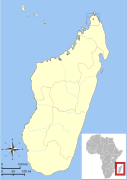
|
Size: 9–13 cm (4–5 in) long, plus 10–14 cm (4–6 in) tail[30] Habitat: Forest[31] Diet: Insect secretions, arthropods, small vertebrates, fruit, and flowers[32] |
VU
|
| Bemanasy mouse lemur
|
M. manitatra Hotaling et al., 2016 |
Southeastern Madagascar | Size: 12–13 cm (5 in) long, plus about 15 cm (6 in) tail Habitat: Forest[33] Diet: Insect secretions, arthropods, small vertebrates, fruit, and flowers[32] |
CR
|
| Bongolava mouse lemur
|
M. bongolavensis Olivieri et al., 2007 |
Northern Madagascar
|
Size: 11–14 cm (4–6 in) long, plus 14–17 cm (6–7 in) tail[34] Habitat: Forest[35] Diet: Insect secretions, arthropods, small vertebrates, fruit, and flowers[32] |
EN
|
| Brown mouse lemur | M. rufus Geoffroy, 1834 |
Southeastern Madagascar
|
Size: About 13 cm (5 in) long, plus about 12 cm (5 in) tail[36] Habitat: Forest[37] Diet: Fruit, as well as insects, leaves, flowers, gum, nectar, and pollen[36] |
VU
|
| Claire's mouse lemur | M. mamiratra Andriantompohavana et al., 2006 |
Northern Madagascar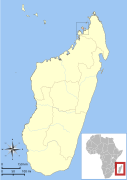
|
Size: 11–14 cm (4–6 in) long, plus 14–17 cm (6–7 in) tail[38] Habitat: Forest[39] Diet: Insect secretions, arthropods, small vertebrates, fruit, and flowers[32] |
EN
|
| Danfoss's mouse lemur
|
M. danfossi Olivieri et al., 2007 |
Northern Madagascar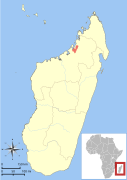
|
Size: 10–12 cm (4–5 in) long, plus 15–17 cm (6–7 in) tail[40] Habitat: Forest[41] Diet: Insect secretions, arthropods, small vertebrates, fruit, and flowers[32] |
VU
|
| Ganzhorn's mouse lemur
|
M. ganzhorni Hotaling et al., 2016 |
Southeastern Madagascar | Size: Habitat: Forest[42] Diet: Fruit and insects[42] |
EN
|
| Gerp's mouse lemur | M. gerpi Radespiel et al., 2012 |
Eastern Madagascar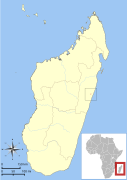
|
Size: 9–10 cm (4 in) long, plus about 15 cm (6 in) tail[43] Habitat: Forest[44] Diet: Insect secretions, arthropods, small vertebrates, fruit, and flowers[32] |
CR
|
| Golden-brown mouse lemur | M. ravelobensis Zimmermann, Cepok, Rakotoarison, Zietemann, & Radespiel, 1998 |
Northern Madagascar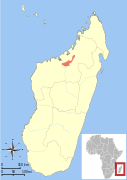
|
Size: 12–14 cm (5–6 in) long, plus 14–18 cm (6–7 in) tail[45] Habitat: Forest[46] Diet: Gum, insect excretions, nectar, fruit, leaves, and animal matter[46] |
VU
|
| Goodman's mouse lemur | M. lehilahytsara Roos & Kappeler, 2005 |
Northeastern Madagascar
|
Size: 9–10 cm (4 in) long, plus 11–12 cm (4–5 in) tail[47] Habitat: Forest[48] Diet: Fruit and insects[48] |
NT
|
| Gray mouse lemur | M. murinus (J. F. Miller, 1777) |
Western and southern Madagascar
|
Size: 12–14 cm (5–6 in) long, plus 13–15 cm (5–6 in) tail[49] Habitat: Forest and shrubland[50] Diet: Insects, as well as small reptiles, plants, leaves, fruit, and flowers[49] |
LC
|
| Jolly's mouse lemur
|
M. jollyae Louis et al., 2006 |
Eastern Madagascar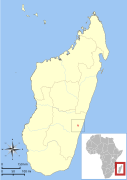
|
Size: 9–10 cm (4 in) long, plus 12–13 cm (5 in) tail[51] Habitat: Forest[52] Diet: Fruit[52] |
EN
|
| MacArthur's mouse lemur
|
M. macarthurii Radespiel et al., 2008 |
Northern Madagascar
|
Size: 11–14 cm (4–6 in) long, plus 13–15 cm (5–6 in) tail[53] Habitat: Forest[54] Diet: Insect secretions, arthropods, small vertebrates, fruit, and flowers[32] |
EN
|
| Madame Berthe's mouse lemur | M. berthae Rasoloarison, Goodman, & Ganzhorn, 2000 |
Western Madagascar
|
Size: 9–11 cm (4 in) long, plus 12–14 cm (5–6 in) tail[55] Habitat: Forest[56] Diet: Honeydew, as well as gum, flowers, fruit, arthropods, and small vertebrates[55] |
CR
|
| Margot Marsh's mouse lemur
Text je dostupný za podmienok Creative Commons Attribution/Share-Alike License 3.0 Unported; prípadne za ďalších podmienok. Podrobnejšie informácie nájdete na stránke Podmienky použitia.
Analytika
Antropológia Aplikované vedy Bibliometria Dejiny vedy Encyklopédie Filozofia vedy Forenzné vedy Humanitné vedy Knižničná veda Kryogenika Kryptológia Kulturológia Literárna veda Medzidisciplinárne oblasti Metódy kvantitatívnej analýzy Metavedy Metodika Text je dostupný za podmienok Creative
Commons Attribution/Share-Alike License 3.0 Unported; prípadne za ďalších
podmienok. www.astronomia.sk | www.biologia.sk | www.botanika.sk | www.dejiny.sk | www.economy.sk | www.elektrotechnika.sk | www.estetika.sk | www.farmakologia.sk | www.filozofia.sk | Fyzika | www.futurologia.sk | www.genetika.sk | www.chemia.sk | www.lingvistika.sk | www.politologia.sk | www.psychologia.sk | www.sexuologia.sk | www.sociologia.sk | www.veda.sk I www.zoologia.sk |



